- Home
- Carlton Mellick III
Crab Town
Crab Town Read online
AUTHOR’S NOTE
Books written by a lot of people I know are usually produced in this order:
1) the book is written
2) the book is titled
3) the back cover description is written
4) cover art is obtained
When I wrote Crab Town, I did all of this in reverse. My usual cover artist Ed Mironiuk had done this image of the girl on the bomb that I really liked. I decided I wanted to write a book based on the image. He was cool with the idea and even gave some plot suggestions, some of which I went with. Then I came up with a description for the book that went with the art. Then I called it Crab Town, because I thought the title somehow went perfectly with the art for no explainable reason. Then, finally, I actually wrote the book.
Crab Town is the first novella I’ve written since Ultra Fuckers, which came out about 9 books ago. I needed to get back into writing them because in my opinion 100 page novellas are the perfect length for bizarro fiction stories. After writing the two epics Warrior Wolf Women of the Wasteland and Zombies and Shit, I thought it was about time to write some shorter books for a change before moving on to the next epic I plan to write, Seven Cyborgs.
I went into this book wanting to just write a fun, dumb little bizarro bank heist story. But I think it became a little more than that. If there were a message to Crab Town it would be: debt is the scariest fucking thing in the world. Well, maybe it’s not scarier than say a tidal wave made of sharks and chainsaws heading toward your children, but it’s one of the most realistic things to fear because it’s the most likely thing that can, and will, fuck over your whole life.
Debt is the reason there aren’t too many full time writers or artists anymore. As a full time writer living my dream, I can have it all taken away from me at any moment. It’s happened to tons of writers that I’ve known. It’s called: not having health insurance. If you’re a full time writer you’re not getting health insurance. You’re lucky enough to be able to pay rent with the small amount of money you’re making. All it takes is to have a medical emergency, which is bound to happen someday, and without health insurance those hospital bills are going to hit you with debt so hard you’ll have to get two back-to-back day jobs in order to pay them off.
Fuck that shit!
Real life just isn’t set up for certain kinds of people, and artists/writers are one of them. Living your dream is worth the risk, sure, but you’ll often find yourself getting the shit end of the stick. So here is a story about several types of people getting the shit end of the stick. But these guys are far from living their dream. In the world of Crab Town, dreams were nuked a long time ago.
- Carlton Mellick III 01/21/2011 4:58pm
Most people are poor these days, but Johnny is so poor he can’t even afford to pay for gravity. They call him Johnny Balloon. That’s basically what he is. A balloon. There are a lot of balloon people these days. The worse the economy gets, the more balloon people you are likely to see walking (or floating) around town.
Only the most desperate individuals shed their humanity to become balloon people. The procedure is free. They basically scoop out all of your insides and turn your mind into a sentient gas which is then put into a human-shaped balloon body.
On the upside, a balloon person will never need to eat or sleep ever again. They never age. They essentially become immortal. But balloon people don’t have the operation because they want to achieve immortality (nobody would choose to live immortally as a balloon); they do it so they can sell their organs, which usually can be sold at a pretty high price. Healthy (or even slightly healthy) organs are always in high demand these days, especially due to all the radiation damage that people have suffered ever since the most recent nuclear war.
Johnny Balloon waves at the people he passes, as he walks down the sidewalk in the middle class district of Freedom City. The people do not wave back, but instead inch away from him with quivering eyes. All balloon people are considered creepy, but Johnny is an especially creepy balloon person. It is because his face is in a permanent smile, so wide that it makes him look like some kind of demented clown doll. When the doctor took the picture that was to be graphed onto Johnny’s balloon head, he suggested that Johnny make a normal face, without expressing any emotion. But Johnny didn’t like that idea. He’d rather look eternally cheerful than express nothing but apathy for the rest of his life.
Johnny tried to make the happiest, most cheerful face possible when the picture was taken. But, after he was converted into a balloon, Johnny realized he might have smiled a little too wide. While looking in the mirror, squeaking his rubber hand against his face, he noticed his smile did make him look a tad bit on the insane side. He still hoped people would realize, after they got to know him, that he was a happy balloon man and not really an insane balloon man.
Most balloon people do not have happy faces painted on their balloons because they usually don’t have anything to be happy about. Nobody enjoys being a balloon. Even the most optimistic balloon people eventually succumb to depression.
This unending depression in balloon people usually comes the first month they get their gravity bill. The doctors never tell their patients that they’ll have to pay for gravity before they get the operation. The balloon people go through with the procedure because they believe they’ll never have to worry about money ever again. But in order to get the gravity device connected to their feet, balloon people must pay a fee of $1750 a month or risk floating away.
All the money the balloon person makes selling his organs usually goes straight to paying off his gravity bills. After a year or so, the balloon person will run out of cash and have his gravity shut off. That is, unless the person has a job, which is unlikely because so few companies hire balloons. The balloon person would have been far better off if he never went through with the operation.
But Johnny tries to be optimistic. He tries to be happy. Even though he was screwed over by yet another scheme of the medical industry, he tries to think it was all for the best. That’s the kind of guy Johnny Balloon is. He doesn’t cry (not that he can cry) over the fact that he can no longer afford to pay for gravity. He figures a way around it.
Instead of spending his last $2000 on one more month of gravity, he said, “Screw gravity!” Then he got rid of his gravity device and saved the rest of his money for entertainment.
“Who needs it, anyway?” he said, as he tied his balloon string to a cinder block in order to weigh himself down. Now he carries the block around with him wherever he goes.
Johnny Balloon is on his way to the bank, but he’s thinking of seeing a movie today. Johnny loves going to the movies. It’s one of the few things a balloon can enjoy. Unfortunately, balloon people are usually not very welcome in movie theaters. The other movie-goers think their squeaky balloon sounds are annoying and ruin the movie-going experience. For this reason, Johnny tries to see movies during the day, when the theater is mostly empty.
Holding a newspaper over his cinder block as he walks, he checks to see what is playing at the town theater. He opens his knapsack and pulls out a watch. It’s still early. He has plenty of time, if things go smoothly. He puts the watch back into the bag, careful not to cut himself on anything sharp within.
Since balloon people have their clothes permanently painted onto their bodies, they don’t have any pockets. They have to store everything in bags they carry. It is possible for balloons to wear watches, but Johnny would rather not. He thinks it feels weird on his wrist.
Johnny stops in his tracks. He looks at the ground. While reading the newspaper, he wasn’t watching where he was going. He almost steps on broken glass. Just like a regular balloon, Johnny Balloon can easily be popped. One little prick will cause his balloon body to explode.
Scanning the ground, there are several broken beer bottles all around him. Slivers of glass cover the sidewalk and the street on both sides. Johnny folds up the newspaper and puts it in his bag, then carefully backs away. He’d rather play it safe and take the long way to the bank than try to tiptoe through the shards of glass.
But as he walks backward, he hears a clink as he kicks some glass with the back of his heel. When he turns around, he realizes there are more broken bottles behind him as well. He wonders how he got through all of that without popping. He must have accidentally stepped in all the right places without paying any attention.
“It must be my lucky day,” he says.
But then he realizes he’s trapped within the circle of glass. He squeak-rubs his forehead, contemplating his best course of action. One of the problems with getting rid of the gravity devices that were attached to his feet is that they used to act as protective footwear. Before, he could have walked over this glass with no worry. Now, it’s not so easy to walk safely through the streets.
Examining carefully, he realizes he’s going to have to jump over it. Safety is only five feet away. He believes he can make it, even if he won’t get much of a running start.
He bends his knees, flexing his rubber legs with a squeak-squeak.
“Come on, Johnny Balloon,” he tells himself. “You can do it.”
Then he jumps, but with the weight of the cinder block in his arms he doesn’t go very far.
“You can’t do it,” he cries, in midair.
As he watches his feet drop toward a sharp blade of glass, Johnny drops the cinder block. With the loss of weight, his body flies away from the ground, spinning toward the sky. Once he’s three stories up, his balloon string goes taut and ceases his ascent. He rolls over in the air and looks down at the people walking by on the street below. None of them seem to notice that he’s floating above them. None of them offer to help him out.
“No problem,” he says. “I’ve prepared for this…”
He swims through the air and grabs the string below him. This is something he’s practiced in his apartment several times before.
“All I have to do is climb down…”
One hand after another, he pulls himself down the string.
“Easy peasy…”
But once he’s seven feet from the ground, he isn’t quite sure what to do from there. The ground is still covered in glass. He tries calling out to the people walking by, but they just ignore him, going around, annoyed that he’s taking up their sidewalk.
“Fine, I don’t need help. I’m sure I can figure this out on my own…”
He tries tugging on his balloon string to pull it across the sidewalk, out of the glass. It moves an inch.
“There you go, Johnny Balloon,” he says. “It’s going to work just fine…”
He pulls it again, harder, moving it a whole foot across the ground this time.
“You’re the smartest balloon in town,” he says with a giggle.
He tugs on it again. The string breaks.
“Wuh…” Johnny says, as he sees the end of the string separate from the cinder block.
He floats further into the air, screaming for help, trying to swim-fly, trying to grab onto the light post that is only another arm’s reach away. Nobody even looks at him. His gaseous brain spins inside his hollow shell of a head as he drifts higher and higher toward the blue abyss above.
When he was a kid in grade school, Johnny learned about the Great Depression in history class.
He asked his teacher, “What’s the difference between the Great Depression and our times?”
The teacher looked out the window at the war torn city and said, “Our times are a heck of a lot worse.”
Johnny didn’t really understand the definition of the word depression, even after his school had closed down due to lack of funding. He regularly heard people call the current era the Greater Depression, but his father said a more apt term for it would be the Infinite Depression…
“Because there’s no hope of ever getting out of this one…”
When Johnny became an adult, the depression only got worse. He lost his job at the canning factory and had to move to the Crab Town area of Freedom City, where all the other jobless people live. The Great Depression Era had Hoovervilles. These days, there are Crab Towns.
“Why’s it called a Crab Town, anyway?” Johnny asked one of his neighbors.
The neighbor was an elderly woman suffering from radiation sickness. She coughed a pool of blood into her palm and wiped it on a crusty brown t-shirt before answering, “Because everyone in this section of city lives in CRABs.”
CRAB stands for Citizen Renovated Abandoned Building. After the end of the war, once neither side could afford to pay for any more bombs to drop, the government proposed the idea of Crab Towns.
“If you can renovate it, you can own it.” That was what they said at the time.
Since many people were out of work and living in the streets, and most of the bombed sections of the city had been abandoned, it seemed like a good way to rebuild the cities while at the same time give the less fortunate citizens somewhere to live. Unfortunately, those who were in need of homes did not have the resources to repair buildings that had been partially leveled by atomic blasts.
But Johnny was happy in his apartment in Crab Town. He used a tarp instead of a south wall, there wasn’t any running water, and he could see into the apartments below and above him via multiple holes, but it was home. And Johnny kind of liked it. That is, until he was so desperate for money that he decided to have the operation to become a balloon man. His apartment wasn’t a very happy place after that. Even those living in Crabs didn’t like having balloon people around.
Johnny grabs hold of a windowsill six stories up. His legs dangling up in the air above his head as he looks inside. There’s a young naked woman near the window, washing soap from her face and semi-pregnant belly with a hose attached to her kitchen sink.
When he sees her, Johnny yells, “Help!” as he tries to climb inside.
The woman sees him and shrieks. She grabs a mildew-encrusted towel and covers her breasts. The cloth is too small to hide the rest of her body, which is coated in razor scars.
“Please,” Johnny cries, his fingers slipping. “Please…”
The woman sneers at him. “Get out of here you perverted creep!”
“No, that’s not it…” Johnny says.
Then she lifts her large sawdust-covered foot and kicks him in the face. His balloon head bounces off of her heel, launching him out of the window.
“I’m floating away!” Johnny yells.
“Serves you right!” The woman pulls a knife out of the kitchen sink and tosses it through the window at him.
The blade barely misses Johnny’s shoulder.
“Don’t do that!” he says.
She throws another knife at him, then a few forks. Johnny’s lucky she’s a bad aim. He drifts up past her window before she can pop him.
A breeze comes in and blows him down the street, toward a crowd of people crossing a busy intersection.
“Help me!” Johnny cries, but nobody bothers looking up.
He blows past them and goes over another group of people down the block.
“Help!”
A fat guy with bloody teeth looks up from his hot dog to watch Johnny’s plight for entertainment. The man smiles and then takes another bite of hot dog.
The balloon string gets tangled up in a tree and catches Johnny from moving any further. His body just whips around in the breeze. After ten minutes of begging for help from passersby, he gives up. He realizes he can’t rely on anyone but himself in this city. He grabs his string and pulls himself in toward the nearest tree branch.
When he gets to the bottom of the trunk, he fills his knapsack with pieces of rubble from the street. Lucky for him, the streets are always filled with debris. Even the buildings in the middle class side of town are falling apart. On
ce his bag is the right weight to keep him on the ground, he unties his string from the branch.
“Thank God that wasn’t a pine tree…”
He waits for a large black sewer crab to cross the sidewalk before continuing on. The sewer crab looks a little too snippy. After all that he’s already been through, Johnny decides he’s going to have to play it safe for the rest of the day.
When Johnny Balloon enters the bank, the place is crowded, even for Liberty Bank. He scans the people in lines, a mixture of middle class and working class people, with a handful of Crab Town residents sprinkled in. It’s going to be hard for him to get out of here in time to catch a movie.
There are two burly guards staring Johnny down as he gets into a line. Cops and security especially hate balloon people. There’s no reason why. They just can’t stand the floating creeps. A man in a yellow hat leans against a wall in the back of the room. He also stares Johnny down. The guy has to be an undercover guard. Every bank has one now. There are too many robberies these days, too many desperate people, and bank security isn’t what it used to be.
The corporate banks went out of business a long time ago. Now, only a few private banks exist in Freedom City. These banks are always packed and always getting hit by desperate criminals.
After ten minutes of waiting, Johnny realizes something is holding up the line. It has hardly moved. A middle-aged woman is at the front of the line, holding everything up. She is a pink lady: pink dress, pink shoes, and pink bow in her hair. Wealthy women like to wear pink or other bright colors. It is a symbol of high class. Nobody else in the room has clothes as bright and clean and new as hers. Most of them don’t even own washing machines.
She is the bank manager’s wife.
That’s when Johnny realizes the woman isn’t even in line. She’s just chatting up the teller. And the teller, an older woman with orange curly hair and white glasses, ignores her customers to gossip with her boss’s wife.

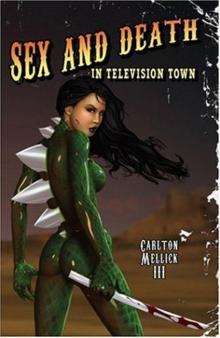 Sex and Death in Television Town
Sex and Death in Television Town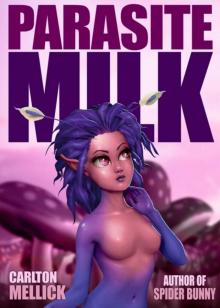 Parasite Milk
Parasite Milk Cuddly Holocaust
Cuddly Holocaust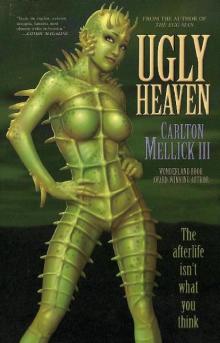 Ugly Heaven
Ugly Heaven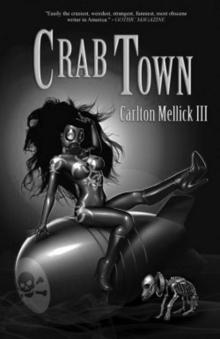 Crab Town
Crab Town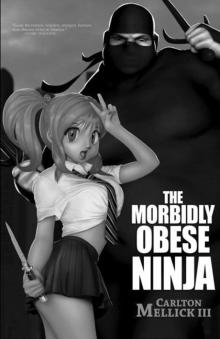 The Morbidly Obese Ninja
The Morbidly Obese Ninja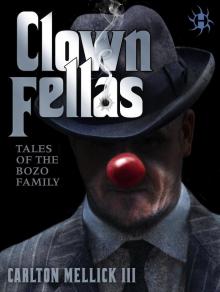 ClownFellas
ClownFellas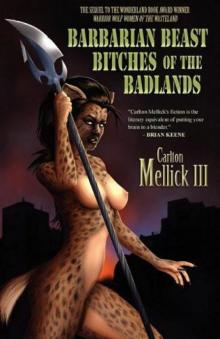 Barbarian Beast Bitches of the Badlands
Barbarian Beast Bitches of the Badlands Zombies and Shit
Zombies and Shit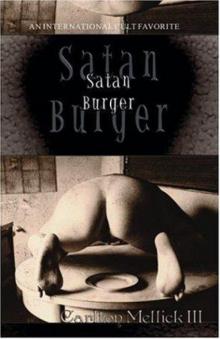 Satan Burger
Satan Burger The Cannibals of Candyland
The Cannibals of Candyland Warrior Wolf Women of the Wasteland
Warrior Wolf Women of the Wasteland Sausagey Santa
Sausagey Santa